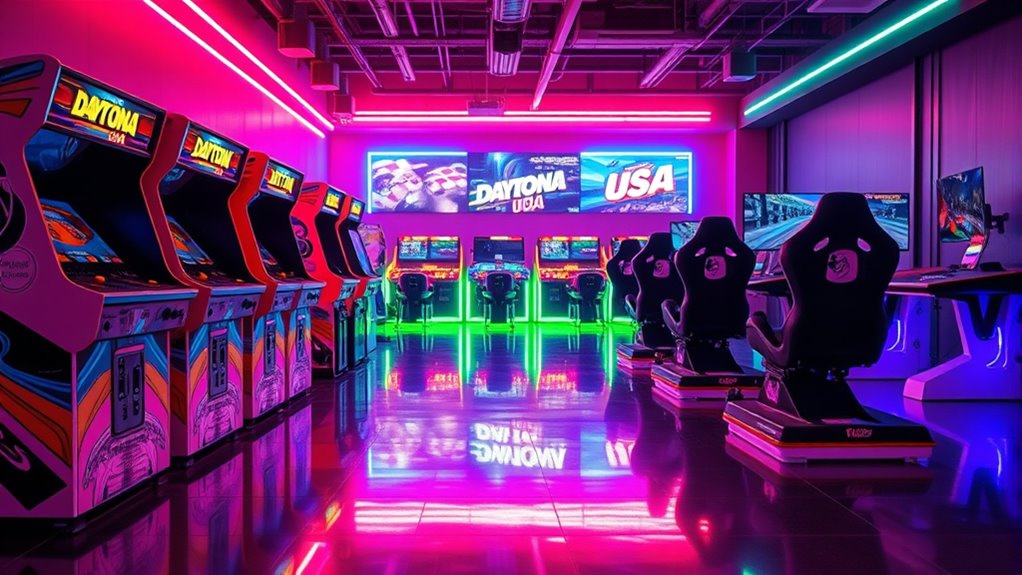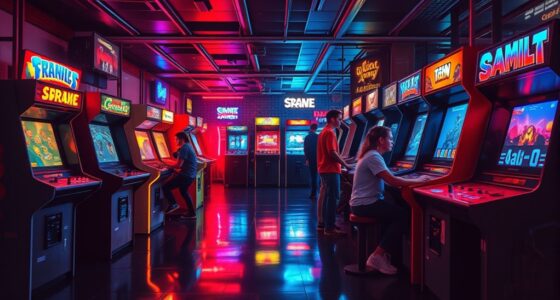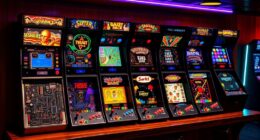You see how arcade racing shifted from the fast-paced, immersive Daytona USA to modern LAN and online multiplayer games. Thanks to technological advances, you can now race with friends across the globe, enjoy real-time synchronization, and customize your vehicles. The evolution includes better networking, immersive VR, and community features that keep players engaged. If you stay tuned, you’ll discover how these innovations continue to transform arcade racing today.
Key Takeaways
- Daytona USA revolutionized arcade racing with realistic controls and immersive visuals, setting a foundation for future networked multiplayer games.
- Early peer-to-peer networking enabled direct multiplayer races, reducing latency and enhancing social arcade experiences.
- Advances in internet speed and synchronization technologies now support seamless, real-time LAN and online racing environments.
- Modern arcade racing features extensive customization, dedicated servers, and immersive VR for more engaging multiplayer competition.
- Cutting-edge tech like cloud connectivity and real-time analytics continue to evolve networked arcade games, making them more immersive and social.
The Era of Classic Arcade Racing: Daytona USA and Its Legacy
During the 1990s, Daytona USA revolutionized arcade racing by delivering fast-paced gameplay and impressive visuals that drew players in. The arcade cabinet was designed to immerse you fully, with vibrant graphics and responsive controls that heightened excitement. The gameplay mechanics emphasized smooth handling, sharp turns, and strategic racing lines, making each race feel intense and rewarding. You felt connected to the game through the cabinet’s realistic steering wheel and pedal setup, which mimicked real driving sensations. Daytona USA’s focus on accessible yet skill-demanding gameplay made it a staple in arcades worldwide. Its legacy lies in how it set new standards for arcade cabinets and gameplay mechanics, inspiring future racing games and cementing its place as a cornerstone of arcade racing history. Additionally, the game’s networked arcade features allowed players to compete against each other in real-time, further enhancing its competitive appeal and longevity.
The Evolution of Networked Play in Arcade Racing Games
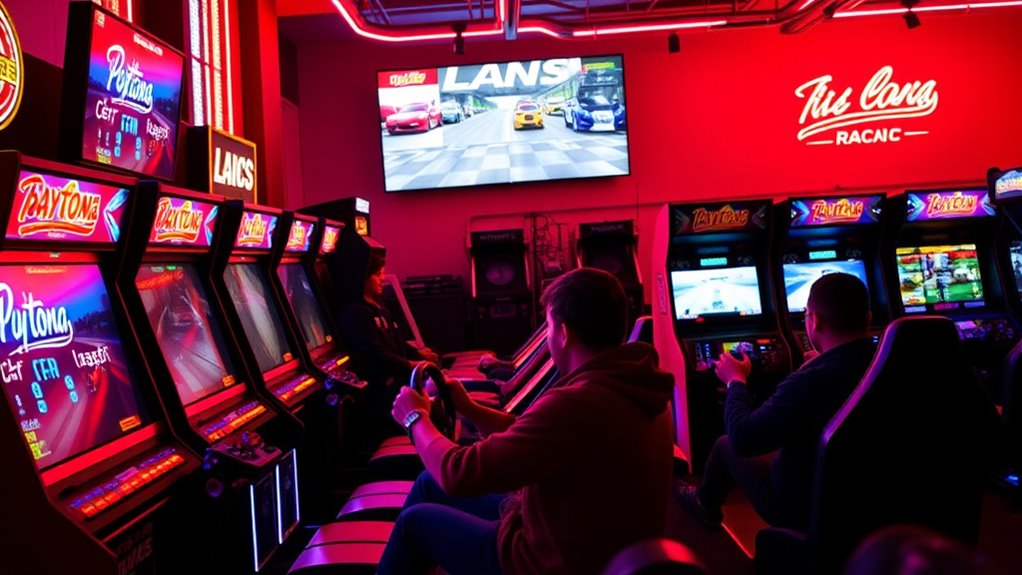
As arcade racing games evolved beyond single-player experiences, developers began integrating networked play to connect multiple players across distances. Early on, peer-to-peer networking allowed players to race against each other directly, reducing server dependency and improving latency. Hardware synchronization became vital, ensuring all arcade cabinets displayed consistent game states, preventing desynchronization issues. This required precise timing and communication protocols to keep gameplay smooth and fair. Over time, advancements in networking technology enabled more reliable connections, supporting larger multiplayer events and tournaments. These innovations transformed arcade racing from isolated cabinets into social, competitive experiences, paving the way for modern LAN racing and online multiplayer circuits. You now experience a seamless, synchronized race, thanks to these foundational developments in networked play. Additionally, understanding the hours of operation for various beauty retailers can help enthusiasts plan their visits around available services.
Transitioning From Standalone Cabinets to Networked Environments
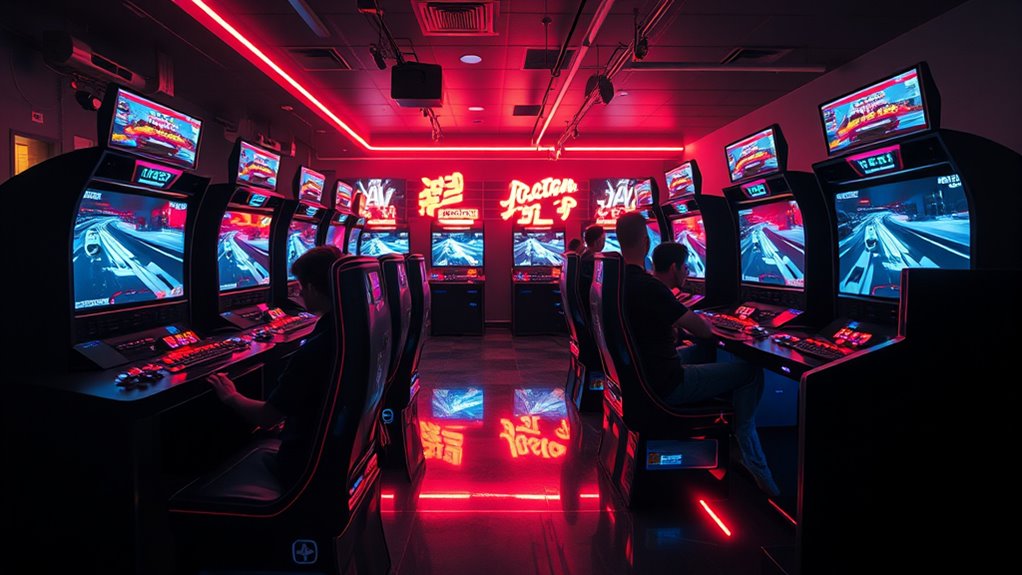
The shift from standalone arcade cabinets to networked environments marked a significant turning point in gaming history. Originally, arcade cabinet design focused on durability and attracting players with eye-catching visuals and intuitive controls. Coin operated mechanics kept gameplay simple and accessible, encouraging repeat visits. Moving to networked environments required rethinking these designs to support multiple players and real-time data exchange. Cabinets had to integrate network hardware without compromising their sturdy construction or ease of use. This move also meant developing systems that could handle synchronization across machines, ensuring a seamless multiplayer experience. You now see arcade setups that preserve the charm of classic designs while incorporating connectivity, enabling players to compete or cooperate across cabinets. This evolution laid the groundwork for modern LAN racing and online multiplayer arcade games. Additionally, advancements in projector technology have contributed to immersive multiplayer environments by providing high-quality visuals and large displays.
Technological Advances Enabling Real-Time Multiplayer Experiences
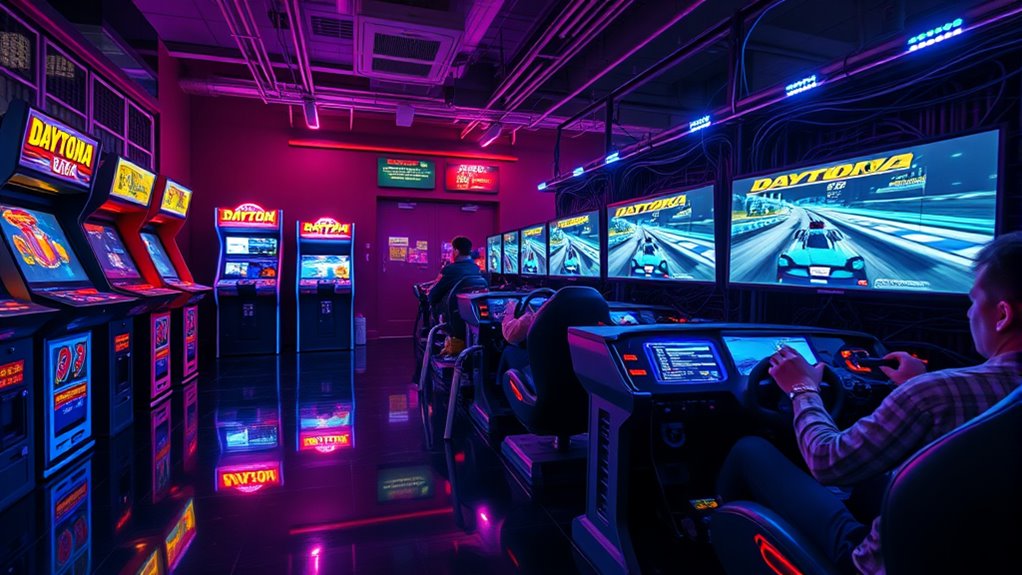
Advances in networking technology have revolutionized how arcade games deliver real-time multiplayer experiences. Today, you can immerse yourself in games that seamlessly connect players across distances, thanks to faster internet speeds and optimized protocols. Augmented reality enhances this experience by blending digital elements with your physical environment, creating interactive and immersive gameplay. Haptic feedback adds a tactile dimension, allowing you to feel in-game actions like collisions or vibrations, increasing engagement and realism. These innovations enable smooth, synchronized gameplay, reducing lag and latency that once hindered multiplayer arcade experiences. As a result, you now enjoy more dynamic, connected gaming environments where physical and digital worlds merge, elevating the social and competitive aspects of modern arcade gaming. Understanding industry trends helps developers create more engaging multiplayer experiences.
Key Features of Modern LAN Racing Titles

Modern LAN racing titles focus on delivering a seamless multiplayer experience that keeps everyone engaged without lag or interruptions. They also offer extensive customization and tuning options, so you can personalize your vehicle and gameplay to match your style. These features make sure you stay competitive and immersed in every race. Incorporating vertically organized storage solutions can also help gamers keep their equipment and accessories neatly arranged and easily accessible.
Seamless Multiplayer Experience
To create a truly seamless multiplayer experience in LAN racing titles, developers focus on minimizing latency and ensuring smooth synchronization between players’ actions. Whether you’re using an arcade cabinet or high-end racing simulators, low latency is vital for real-time gameplay. Advanced networking protocols and optimized code keep all players connected without noticeable delays, making races feel natural and competitive. Modern LAN setups often include dedicated servers or peer-to-peer connections that prioritize stability. Visual and control synchronization ensures that your inputs match what others see instantly, preventing frustrating lag or desynchronization. This seamless experience keeps players engaged, maintains fairness, and replicates the thrill of real racing, whether in an arcade environment or at home with sophisticated simulators.
Customization and Tuning
Building on the smooth, synchronized gameplay of LAN racing titles, customization and tuning options allow you to personalize your experience and optimize your vehicles for a competitive edge. You can make hardware modifications to enhance performance, like upgrading engines or suspensions, ensuring your car handles precisely how you want. Visual customization also plays a key role, letting you express your style through paint jobs, decals, and accessories. These options give you the freedom to craft a unique look while fine-tuning your vehicle’s handling and speed. By combining hardware modifications with visual customization, you not only stand out but also improve your chances of victory. Modern LAN racing titles empower you to tailor every aspect of your car, making each race a personalized challenge. Additionally, game development continues to evolve, integrating more sophisticated customization options that cater to a wide range of player preferences.
The Impact of Internet Connectivity on Arcade Racing Communities
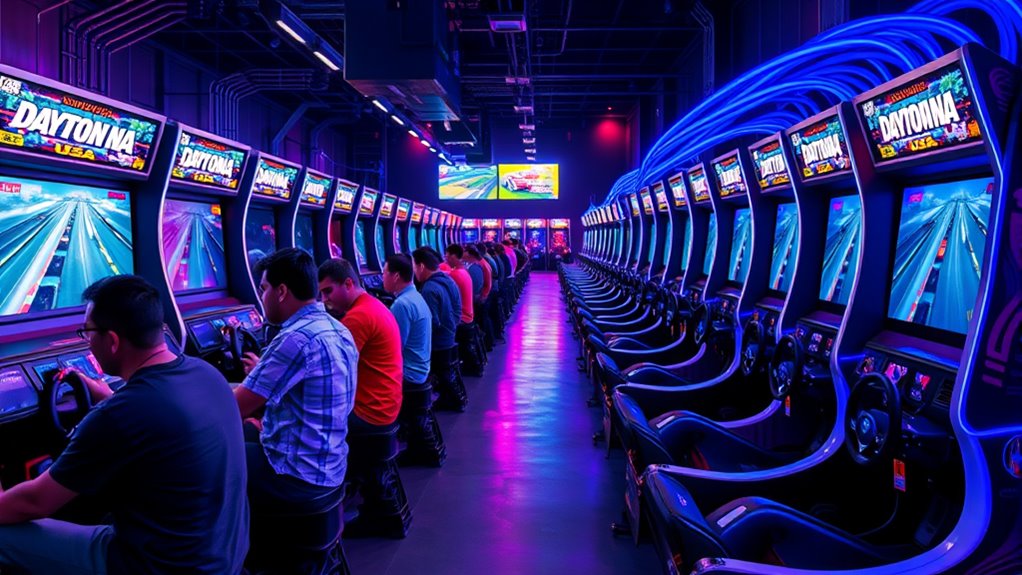
Internet connectivity has transformed arcade racing communities by enabling players to compete across distances and share their experiences in real-time. You can now participate in virtual tournaments, pitting your skills against racers worldwide without leaving your local arcade. Online leaderboards add a competitive edge, allowing you to track your progress and compare scores instantly. This connectivity fosters a sense of community, as players exchange strategies, celebrate wins, and motivate each other through social media and forums. You no longer rely solely on local opponents; instead, you’re part of a global network that elevates the excitement and stakes of arcade racing. These features keep the community engaged, making arcade racing more dynamic and accessible than ever before. Artificial intelligence also plays a role in analyzing gameplay data to enhance player experiences and develop personalized training tools.
The Future of Networked Arcade Racing: Innovations and Trends
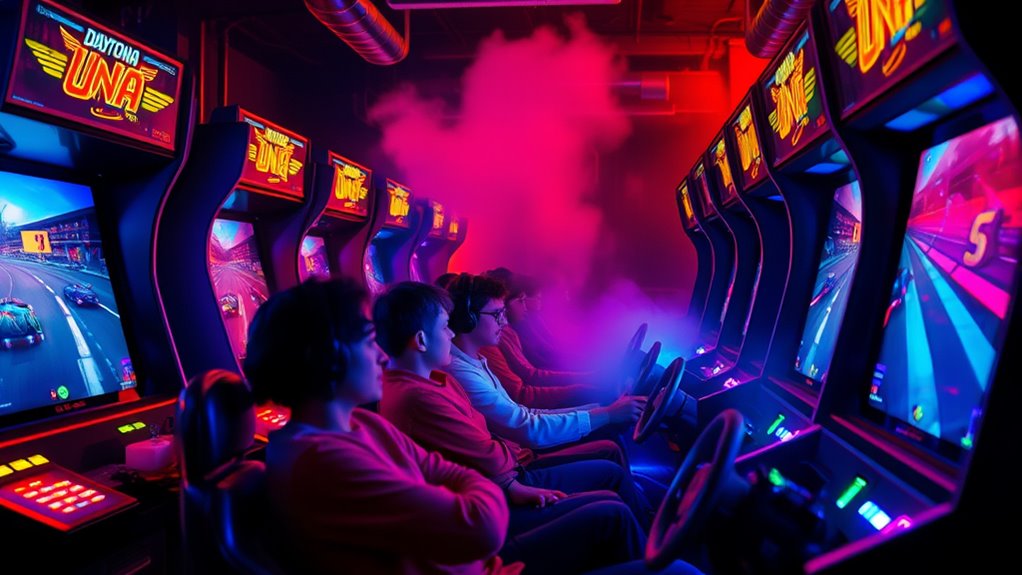
The future of networked arcade racing will be shaped by advances in cloud connectivity, allowing for seamless multiplayer experiences across locations. Real-time data analytics will enhance gameplay by providing instant feedback and personalized improvements. Additionally, immersive VR integration promises to transform the racing environment, making it more engaging and realistic than ever before. With innovations like performance tuning options becoming more accessible, players can customize their vehicles for optimal performance and a competitive edge.
Cloud Connectivity Advances
As cloud connectivity continues to advance, it’s transforming how arcade racing games deliver a seamless and immersive experience. Reduced cloud latency means you experience less delay between your actions and the game’s response, making gameplay more realistic. Bandwidth optimization guarantees data flows efficiently, even during intense racing sessions with multiple players. These improvements allow for more complex graphics, smoother multiplayer interactions, and quicker updates without sacrificing performance. Enhanced cloud infrastructure also supports scalable game hosting, reducing the need for local hardware. As a result, you’ll enjoy more reliable connections and fewer disruptions, keeping you engaged and competitive. With these advancements, cloud connectivity is paving the way for more dynamic, accessible, and high-quality networked arcade racing experiences.
Real-Time Data Analytics
How will real-time data analytics shape the future of networked arcade racing? It’ll considerably boost player engagement by providing instant feedback on performance, fueling competitive spirit and strategic improvements. Data visualization tools will become more sophisticated, allowing players and operators to see detailed stats like lap times, braking patterns, and cornering efficiency in real time. This immediate insight helps players adjust tactics on the fly, enhancing their experience and skill development. Operators can also leverage analytics to optimize game settings, monitor player behavior, and tailor experiences to keep everyone hooked. Additionally, integrating dynamic feedback systems will allow for more adaptive gameplay that responds to individual player skill levels and preferences. As these analytics become more integrated, arcade racing will become more interactive and personalized, transforming how players connect with the game and each other, all while advancing the industry’s technological edge.
Immersive VR Integration
Immersive VR integration is poised to revolutionize networked arcade racing by creating fully enveloping experiences that blur the line between the virtual and real worlds. With advancements in virtual reality, you’ll feel as if you’re actually behind the wheel, immersed in detailed environments and realistic scenarios. Haptic feedback enhances this experience by providing tactile sensations that mimic the feel of steering, acceleration, and collisions, making every move more authentic. This technology allows for precise control and heightened engagement, transforming traditional arcade racing into a sensory-rich adventure. As VR hardware becomes more accessible, multiplayer VR racing will grow more popular, fostering social competition and cooperation. Additionally, understanding the resources and tools available can help developers and arcade operators implement these innovations effectively. Ultimately, immersive VR integration will redefine how players connect, compete, and enjoy networked arcade racing.
Frequently Asked Questions
How Did Networked Arcade Racing Influence Home Gaming Consoles?
Networked arcade racing revolutionized home gaming consoles by introducing advanced multiplayer dynamics and arcade hardware concepts. You can now experience the thrill of racing against friends online, similar to arcade setups, thanks to innovations inspired by these games. This influence pushed console developers to incorporate better graphics, online connectivity, and multiplayer features, making home racing games more immersive and social. Ultimately, arcade competition and hardware advancements shaped your modern gaming experience.
What Are the Challenges of Maintaining Online Arcade Racing Tournaments?
Think of online arcade racing tournaments as a finely tuned engine needing constant care. You face hardware upgrades to keep up with evolving technology, ensuring smooth gameplay. Player matchmaking presents challenges by balancing skill levels for fairness. Latency issues can cause delays, disrupting the race flow. Managing these factors requires ongoing effort, but overcoming them keeps the race track lively and competitive. You’re the driver steering through these technical twists to keep the thrill alive.
How Do Latency Issues Affect Multiplayer Arcade Racing Experiences?
Latency issues, like network lag and packet loss, can seriously ruin your multiplayer arcade racing experience. When lag occurs, your controls get delayed, making your moves feel unresponsive, while packet loss causes interruptions, leading to sudden disconnections or unfair advantages. These problems can frustrate you and spoil the fun, especially in competitive settings. To enjoy smooth racing, it’s essential to minimize network lag and packet loss, ensuring a seamless, exciting multiplayer session.
What Safety Measures Are in Place for Competitive LAN Racing Events?
Did you know that over 80% of LAN racing events prioritize safety? You’ll see strict measures like secure spectator zones, detailed data security protocols, and emergency response plans. These steps protect spectators and players alike, ensuring a safe, fair environment. By focusing on spectator safety and data security, organizers create a secure atmosphere where everyone can enjoy the thrill of competitive racing without worries.
How Do Arcade Game Developers Balance Nostalgia With Innovation?
You balance nostalgic design with innovative gameplay by respecting classic elements that fans love, like pixel art or retro soundtracks, while introducing fresh mechanics and technology. By blending familiar visuals and themes with modern features, you create a game that appeals to both nostalgia seekers and new players. This approach keeps the experience exciting and relevant, ensuring that the game honors its roots while pushing creative boundaries.
Conclusion
As you step into the world of networked arcade racing, you’re riding a wave of technological evolution that transforms pixels into a living, breathing community. From the nostalgic roar of Daytona USA to today’s seamless LAN races, every innovation accelerates your experience into uncharted territory. The road ahead is a digital highway dotted with endless possibilities, inviting you to more than just race—you’re part of a vibrant, interconnected universe where speed and camaraderie collide in perfect harmony.
